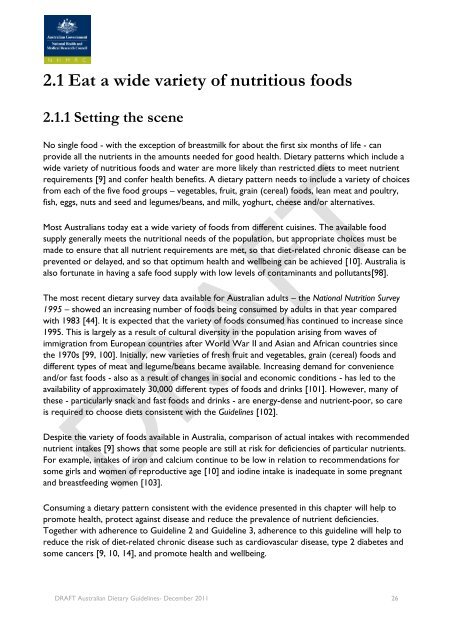DRAFT Australian Dietary Guidelines - Eat For Health
DRAFT Australian Dietary Guidelines - Eat For Health
DRAFT Australian Dietary Guidelines - Eat For Health
You also want an ePaper? Increase the reach of your titles
YUMPU automatically turns print PDFs into web optimized ePapers that Google loves.
2.1 <strong>Eat</strong> a wide variety of nutritious foods<br />
2.1.1 Setting the scene<br />
No single food - with the exception of breastmilk for about the first six months of life - can<br />
provide all the nutrients in the amounts needed for good health. <strong>Dietary</strong> patterns which include a<br />
wide variety of nutritious foods and water are more likely than restricted diets to meet nutrient<br />
requirements [9] and confer health benefits. A dietary pattern needs to include a variety of choices<br />
from each of the five food groups – vegetables, fruit, grain (cereal) foods, lean meat and poultry,<br />
fish, eggs, nuts and seed and legumes/beans, and milk, yoghurt, cheese and/or alternatives.<br />
Most <strong>Australian</strong>s today eat a wide variety of foods from different cuisines. The available food<br />
supply generally meets the nutritional needs of the population, but appropriate choices must be<br />
made to ensure that all nutrient requirements are met, so that diet-related chronic disease can be<br />
prevented or delayed, and so that optimum health and wellbeing can be achieved [10]. Australia is<br />
also fortunate in having a safe food supply with low levels of contaminants and pollutants[98].<br />
The most recent dietary survey data available for <strong>Australian</strong> adults – the National Nutrition Survey<br />
1995 – showed an increasing number of foods being consumed by adults in that year compared<br />
with 1983 [44]. It is expected that the variety of foods consumed has continued to increase since<br />
1995. This is largely as a result of cultural diversity in the population arising from waves of<br />
immigration from European countries after World War II and Asian and African countries since<br />
the 1970s [99, 100]. Initially, new varieties of fresh fruit and vegetables, grain (cereal) foods and<br />
different types of meat and legume/beans became available. Increasing demand for convenience<br />
and/or fast foods - also as a result of changes in social and economic conditions - has led to the<br />
availability of approximately 30,000 different types of foods and drinks [101]. However, many of<br />
these - particularly snack and fast foods and drinks - are energy-dense and nutrient-poor, so care<br />
is required to choose diets consistent with the <strong>Guidelines</strong> [102].<br />
Despite the variety of foods available in Australia, comparison of actual intakes with recommended<br />
nutrient intakes [9] shows that some people are still at risk for deficiencies of particular nutrients.<br />
<strong>For</strong> example, intakes of iron and calcium continue to be low in relation to recommendations for<br />
some girls and women of reproductive age [10] and iodine intake is inadequate in some pregnant<br />
and breastfeeding women [103].<br />
Consuming a dietary pattern consistent with the evidence presented in this chapter will help to<br />
promote health, protect against disease and reduce the prevalence of nutrient deficiencies.<br />
Together with adherence to Guideline 2 and Guideline 3, adherence to this guideline will help to<br />
reduce the risk of diet-related chronic disease such as cardiovascular disease, type 2 diabetes and<br />
some cancers [9, 10, 14], and promote health and wellbeing.<br />
<strong>DRAFT</strong> <strong>Australian</strong> <strong>Dietary</strong> <strong>Guidelines</strong>- December 2011 26

















